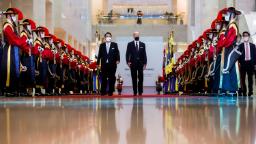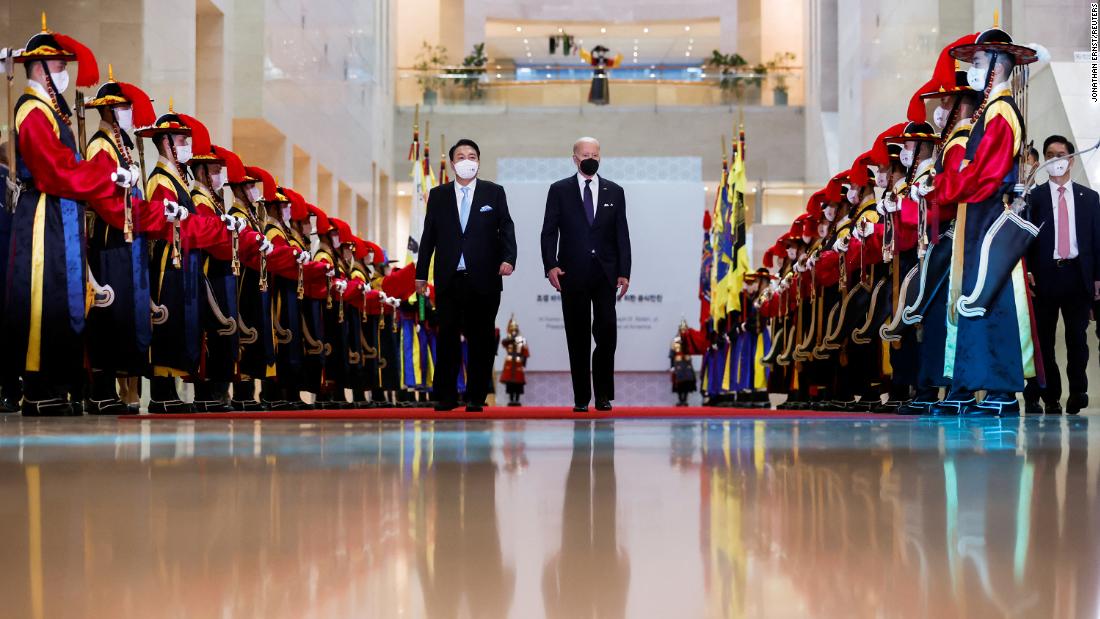
And during a news conference here Saturday, he did not sound particularly eager for a handshake with the North Korean despot.
“That would depend on whether he’s sincere and whether he’s serious,” Biden said when asked whether he’d be willing to meet Kim.
The days of glitzy, leader-to-leader summits and other photo ops that defined President Donald Trump’s diplomatic forays with North Korea and elevated Kim appear over for now. So are the attempts at a grand bargain, “everything for everything” denuclearization agreement.
Instead, Biden administration officials are focused on shows of strength and unity with South Korea and what they call a “calibrated, practical approach,” seeking incremental progress toward denuclearization through sustained diplomatic engagements. And Kim, once again isolated on the world stage and unable to grip and grin with a US president, appears poised to reach for a headline-grabbing intercontinental ballistic missile test while Biden is in the region instead.
One year after the Biden administration completed a review of its North Korea policy, Biden’s first trip to South Korea now puts him at the center of the still unproven new strategy.
Testing Biden’s response
Jake Sullivan, the US national security adviser, has said the US is “prepared” for the possibility of a North Korean missile or nuclear test while Biden is in the region and that the President could consequently adjust the US’s military posture in the region.
“If something does occur, it will only serve to reinforce and highlight the fact that the United States is going to be engaged in the Indo-Pacific, is going to be a stalwart ally, and is going to stand up to and not shrink from any acts of aggression,” Sullivan told reporters aboard a South-Korea bound Air Force One.
To date, the President’s strategy has yet to yield a single working meeting with North Korea in the year since the administration completed a review of the US policy toward the hermit kingdom, a senior administration official said, adding that “it has not been for lack of trying.” And North Korea has also quickened the pace of its ballistic missile tests — launching 15 this year, so far.
“We are obviously concerned,” the official said of the tests. “But we remain committed to our fundamental approach, which is we will do what we need to do on security for us, for our allies, for our deployed forces. And at the same time, we will continue enforcing (United Nations) Security Council resolutions and urging others and pressing others to do the same. But we will continue reaching out to the North and making clear that we seek diplomacy with them. We seek engagement.”
“Unfortunately, up until now — I think we have to be honest about this — they have not been willing to,” the senior official added.
With diplomacy stalled, Biden and South Korean President Yoon Suk Yeol announced their intent to expand joint military exercises, bolstering a key component of military cooperation that Trump had sought to end.
Covid in North Korea could be an opportunity for engagement
US officials and North Korea experts pinned the country’s lack of diplomatic engagement with the US and other countries in part on the draconian coronavirus lockdown measures the hermit kingdom has had in place throughout Biden’s time in office.
While US officials do not believe the outbreak will hamper North Korea’s ability to conduct a missile test, they have also watched carefully for signs it could accept South Korean or international help to combat the outbreak.
“The hope is that they will be more willing to engage on Covid-related humanitarian assistance and that this could potentially serve as a means to thaw a diplomatic track that’s been frozen since the failed US-North Korea summit in Hanoi,” said Patricia Kim, a David M. Rubenstein fellow at the Brookings Institution. “So, I think there is hope there.”
A senior administration official said the US has previously told North Korea it is willing to engage in discussions about coronavirus relief aid but has not had any direct outreach since the latest outbreak. Pyongyang has yet to respond to the new government in Seoul’s offer of coronavirus assistance.
A major shift from Trump’s showman diplomacy
Trump’s policy toward North Korea mirrored the erratic nature of his presidency. Warned by then-President Barack Obama in the Oval Office in 2016 that Pyongyang would present him his gravest national security threat, Trump adopted a bellicose approach to the North and its leader in the early days of his presidency.
From his summer home in New Jersey, Trump threatened to rain “fire and fury” on North Korea should its provocations continue. He bragged that his “nuclear button” was larger than Kim’s. And during a speech at the United Nations, he referred to the dictator as “Little Rocket Man,” an insult he devised to reduce his foe to a caricature.
Yet as time went on — and, in Trump’s view, as his rhetoric drew Kim in — the policy swung hard in another direction. After a historic summit in Singapore, the first between a US and North Korean leader, the men exchanged what Trump later called “love letters.” They met again in Hanoi, though those talks fell apart over differences in sanctions relief.
Biden, for his part, will forego a visit to the DMZ altogether, with officials saying he opted instead for a briefing at Osan Air Base, having already toured the DMZ as vice president.
Trump’s efforts seemed to prompt a pause in North Korean provocations, with a reduction in missile and nuclear tests. Yet substantively, efforts to convince Kim to halt his nuclear program stalled and ultimately yielded no progress toward the ultimate goal of denuclearization.
“I think the Biden administration has tried to distinguish its North Korea policy by making the case that it’s not interested in flashy summits or grand bargains, but that it wants to take a practical and calibrated approach to build towards the complete denuclearization of North Korea,” said Patricia Kim. “I think the hang up, of course, is not so much US policy, but the fact that North Korea seems to have zero interest in talking about denuclearization.”
While Trump sought to cultivate Kim as a partner and personal friend, he cast skepticism at the necessity of keeping US troops on the Korean Peninsula and levied stiff tariffs on South Korean goods, steps that caused deep anxiety in Seoul and the broader region over American commitment to security.
“There is clearly a sigh of relief after Biden came to the region and talked about alliances in a language that allies understood. They just didn’t understand, did not comprehend, what Trump had been saying,” said Victor Cha, the Korea chair at the Center for Strategic and International Studies in Washington.

